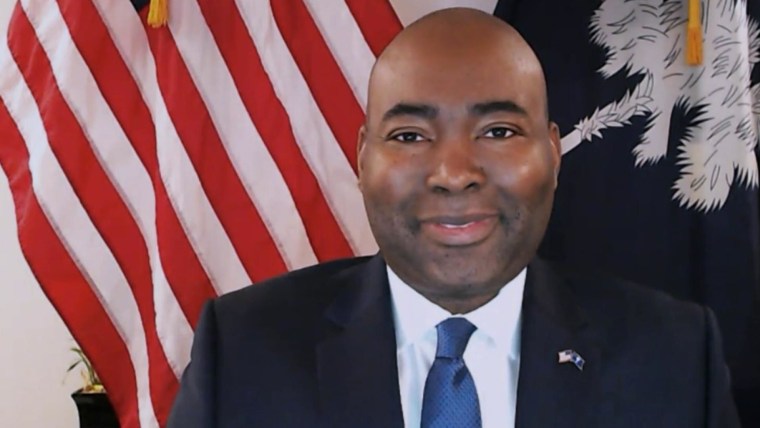WASHINGTON — President Joe Biden and the new Democratic Congress were just sworn in, but the clock has already started on the 2022 midterm elections, when voters will decide if the president gets more than two years to advance his agenda with a friendly Congress.
Democrats have to defend a narrow 221-211 majority in the House (218 seats are needed for control) and the 50-50 Senate, where losing even a single seat will cost the party the chamber.
History is not on their side. Americans typically put a check on power, and the president’s party has lost House seats in nearly every midterm since the 1930s. They typically suffer big losses in their first midterm.
“In 2020, House Republicans won 28 out of the 29 most competitive districts by highlighting the exact job-killing policies Joe Biden has enacted during his first week in office,” said Michael McAdams, spokesperson for the National Republican Congressional Committee, the campaign arm of the House GOP. “If House Democrats thought 2020 was bad, they aren’t the slightest bit prepared for what the 2022 cycle has in store.”
The one recent exception to that historical trend was 2002, when the country rallied around President George W. Bush in the wake of the September 11 terror attacks and his GOP picked up seats.
Democrats now hope that if Biden can succeed in fighting a different crisis — the Covid-19 pandemic — and Democrats go back to knocking doors after stopping for the pandemic, voters will reward them.
“Organize, organize, organize. That is how we bucked history and won two runoff elections in Georgia,” new Democratic National Committee chairman Jaime Harrison said on MSNBC Friday.
It’s early yet, and there are more questions than answers about the next two years of American politics. Here are the five big ones:
1. What does Trump do?
In his final public remarks as president, Donald Trump said he’d “be back in some form.” Even after being impeached twice and banned from Twitter, Trump remains overwhelmingly popular among Republican voters and just 5 percent said they regretted voting for him after this month’s deadly insurrectionist riot at the Capitol.
Democrats have done best when they can run against Trump without him being on the ballot, such as in the 2018 midterms and the Georgia Senate runoffs and say Republicans will have hard time washing their hands of Trump after the attack on democracy.
“It makes it impossible for them to turn around and recruit the classic suburban country club Republican banker to run for Congress,” said Tyler Law, a Democratic operative who works on House races. “Plenty of people will have forgotten his crude comments in a few years. Americans won’t forget the time our Capitol was raided by domestic terrorists clad in Trump gear.”
2. What happens to the GOP?
Even if Trump decides to spend his on the golf course, the Republican Party he left behind is facing an internal reckoning over his influence and their future.
Trump helped juice turnout from the party’s shrinking base — they’ve won the presidential popular vote only once in 32 years — but with him gone, some want to double down on Trumpism while others want to move on.
“There are going to be some pretty competitive, if not brutal, primaries for Senate nominations in places like Georgia, Arizona and others,” said Matt Gorman, a Republican strategist who has worked on House races.
Still, Republicans found themselves in a similar position after Barack Obama’s 2008 election and surged back to victory in the midterms, and Democrats did the same after Trump’s 2016 win.
3. All about the base?
In the past, it’s been hard for Democrats to get their base to turn out in non-presidential elections, and after four years of near-constant protesting and donating and worrying, the party’s voters may be eager for a break from politics.
Republicans, meanwhile, face their own challenge in turning out their base without Trump, and that may be harder if he stokes sentiment that Republicans betrayed him.
They also face some financial headwinds after major corporations said they would cut off donations because of the Capitol riot, at least for a while, and with the sidelining or death of some of their biggest funders, like the National Rifle Association.
“Democrats have obviously cultivated their online donor base far better than Republicans, but a lot of that was the sort of rage-donating against Trump,” said Jessica Taylor, an analyst with the Cook Political Report who tracks Senate races. “I’m not sure you will have Republicans rage-donating the same way, because Biden is not divisive in the same way.”
4. What about Biden?
Both of Biden’s predecessors entered the White House with complete control of Washington and faced almost immediate grassroots uprisings that culminated in a “shellacking” in the midterms, as Obama memorably put it.
Trump’s inauguration was overshadowed by the Women’s March just a day later. And Obama, despite starting out with astronomical approval ratings, saw the first stirrings of conservative backlash in Tea Party rallies organized in February 2009, just over a month after he took office.
Biden, strategists in both parties agree, is less divisive than either Obama or Trump. And conservatives have had a difficult time turning the president into a boogeyman that animates and enrages their base like, say, Hillary Clinton.
Covid-19 restrictions might make it more difficult for popular protests to build — but backlash to ongoing social distancing restrictions might also provide the spark around which a new movement catches fire.
Can Biden stop the pandemic and build the economy back better, as he’s promised? Will his administration face scandals? Most do.
5. What’s the map look like?
States are still redrawing their maps after the once-a-decade Census, so we don’t yet know what congressional districts will look like in 2022. Some states with shrinking populations like New York are expected to lose seats in Congress, while others, like booming Texas, are expected to gain some.
“I think Republicans are well positioned to retake the House, but the $64,000 question is, ‘What does redistricting look like?'” asked Gorman, the Republican strategist.
Republicans have the upper hand in the states after 2020 proved to be a disappointing year down-ballot for Democrats, but it’s not as lopsided as it was last time, after 2010.
Meanwhile, in the Senate, the map is set. Democrats have to defend Sens. Raphael Warnock, D-Ga., and Mark Kelly, D-Ariz., who just won special elections, but have to run again to seek a full six-year term. They also have senators up for re-election in New Hampshire and Nevada, which Biden carried only narrowly.
On the Republican side, Pennsylvania Sen. Pat Toomey is retiring, leaving behind an open seat in a state Biden carried. Wisconsin Sen. Ron Johnson, a staunch conservative, is up for re-election in another Biden state. And the GOP will have to defend seats in battleground North Carolina and Florida as well.
Source: | This article originally belongs to Nbcnews.com










